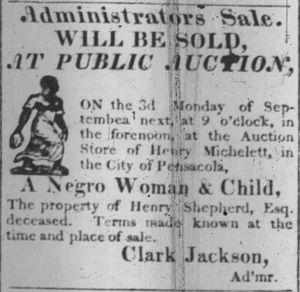Difference between revisions of "Henrique Michelet"
m |
|||
| (One intermediate revision by the same user not shown) | |||
| Line 30: | Line 30: | ||
[[File:MicheletAuction1823.jpg|thumb|right]] | [[File:MicheletAuction1823.jpg|thumb|right]] | ||
| − | Michelet frequently hosted slave auctions at his [[Baylen Street]] auction house. Advertisements in the ''Pensacola Gazette'' detail at least | + | Michelet frequently hosted slave auctions at his [[Baylen Street]] auction house. Advertisements in the ''Pensacola Gazette'' detail at least 40 slaves who were sold by Michelet at auction: |
*One enslaved woman and child — September 15, 1823<ref>Pensacola Gazette. 30 August 1823.</ref> | *One enslaved woman and child — September 15, 1823<ref>Pensacola Gazette. 30 August 1823.</ref> | ||
*Enslaved woman named [[Maria Paty]] — July 20, 1825<ref>Pensacola Gazette. 13 July 1825.</ref> | *Enslaved woman named [[Maria Paty]] — July 20, 1825<ref>Pensacola Gazette. 13 July 1825.</ref> | ||
*One enslaved male — September 22, 1830<ref>Pensacola Gazette. 18 September 1830.</ref> | *One enslaved male — September 22, 1830<ref>Pensacola Gazette. 18 September 1830.</ref> | ||
| + | *Eight enslaved persons — May 26, 1834<ref>Pensacola Gazette. 26 April 1834.</ref> | ||
*19 enslaved persons — May 6, 1839<ref>Pensacola Gazette. 4 May 1839.</ref> | *19 enslaved persons — May 6, 1839<ref>Pensacola Gazette. 4 May 1839.</ref> | ||
| − | * | + | *Four enslaved persons — July 1, 1839<ref>Pensacola Gazette. 15 June 1839.</ref> |
| − | *Three enslaved | + | *Three enslaved men and two enslaved women — July 22, 1839<ref>Pensacola Gazette. 13 July 1839.</ref> |
Michelet also personally owned slaves; his 1841 will records four enslaved individuals among the property to be divided between his wife and daughters.<ref name="will" /> Escambia County deed books record at least four instances in which Michelet personally bought or sold enslaved persons.<ref name="deed" /> | Michelet also personally owned slaves; his 1841 will records four enslaved individuals among the property to be divided between his wife and daughters.<ref name="will" /> Escambia County deed books record at least four instances in which Michelet personally bought or sold enslaved persons.<ref name="deed" /> | ||
| Line 44: | Line 45: | ||
{{bio-stub}} | {{bio-stub}} | ||
| + | [[Category:Slave dealers|Michelet, Henrique]] [[Category:Pensacola City Council members|Michelet, Henrique]] | ||
Latest revision as of 08:37, 18 March 2020
| Henrique Michelet | |
|---|---|
| Born | 1776 Marseilles, France |
| Died | May 31, 1841 Pensacola, Florida |
| Occupation | Auctioneer, slave dealer, alderman |
| Spouse | Dionisia de la Cruz |
| Children | Anna Maria Croix Michelet Maria Gertrudis Michelet Maria Theresa Michelet |
Henrique Michelet, also known as Henry Michelet, was a Pensacola slave dealer, auctioneer, and city alderman.
A native of Marseilles, France,[1] Michelet married Dionisia de la Cruz in Cádiz, Spain in 1795, and the couple had three daughters, each of whom was born in Cádiz.
Michelet later emigrated to the United States, settling in Pensacola, where he operated an auctioneer business. In 1821, when Pensacola became United States territory, Andrew Jackson formed a municipal government and appointed Michelet as a city alderman.
At the time of his death in 1841, Michelet was a substantial landowner, holding hundreds of acres on the Escambia River as well as Bayou Chico. Michelet also once owned the land on the western end of Santa Rosa Island that became home to Fort Pickens. On May 28, 1828, the United States purchased 1,181 arpents (about 997 acres) from Michelet for the sum of $4,000.[2]
Michelet's residence — and possibly the location of his auction house — was Lot 118, Old City Tract, on the northwest corner of Baylen and Government Streets.[1] In 1825, Michelet also purchased the lot adjoining to the north (Lot 137).[3]
Involvement in the slave trade[edit]
Prior to the United States' annexation of West Florida in 1821, Michelet was involved in the importation of slaves to Pensacola. In 1818, several vessels left Havana, Cuba, bound for Pensacola with cargoes of African slaves, some of whom were consigned to Michelet. The vessels were seized by the United States before landing in Pensacola, however.[4]
Michelet frequently hosted slave auctions at his Baylen Street auction house. Advertisements in the Pensacola Gazette detail at least 40 slaves who were sold by Michelet at auction:
- One enslaved woman and child — September 15, 1823[5]
- Enslaved woman named Maria Paty — July 20, 1825[6]
- One enslaved male — September 22, 1830[7]
- Eight enslaved persons — May 26, 1834[8]
- 19 enslaved persons — May 6, 1839[9]
- Four enslaved persons — July 1, 1839[10]
- Three enslaved men and two enslaved women — July 22, 1839[11]
Michelet also personally owned slaves; his 1841 will records four enslaved individuals among the property to be divided between his wife and daughters.[1] Escambia County deed books record at least four instances in which Michelet personally bought or sold enslaved persons.[3]
References[edit]
- ↑ 1.0 1.1 1.2 Will of Henrique Michelet, 1841 [1]
- ↑ Bearss, Edwin C. Historic Structure Report, Fort Pickens. U.S. Department of the Interior, 1983.
- ↑ 3.0 3.1 Escambia County Deed Books
- ↑ Letter from the Secretary of the Treasury 1826 [2]
- ↑ Pensacola Gazette. 30 August 1823.
- ↑ Pensacola Gazette. 13 July 1825.
- ↑ Pensacola Gazette. 18 September 1830.
- ↑ Pensacola Gazette. 26 April 1834.
- ↑ Pensacola Gazette. 4 May 1839.
- ↑ Pensacola Gazette. 15 June 1839.
- ↑ Pensacola Gazette. 13 July 1839.
